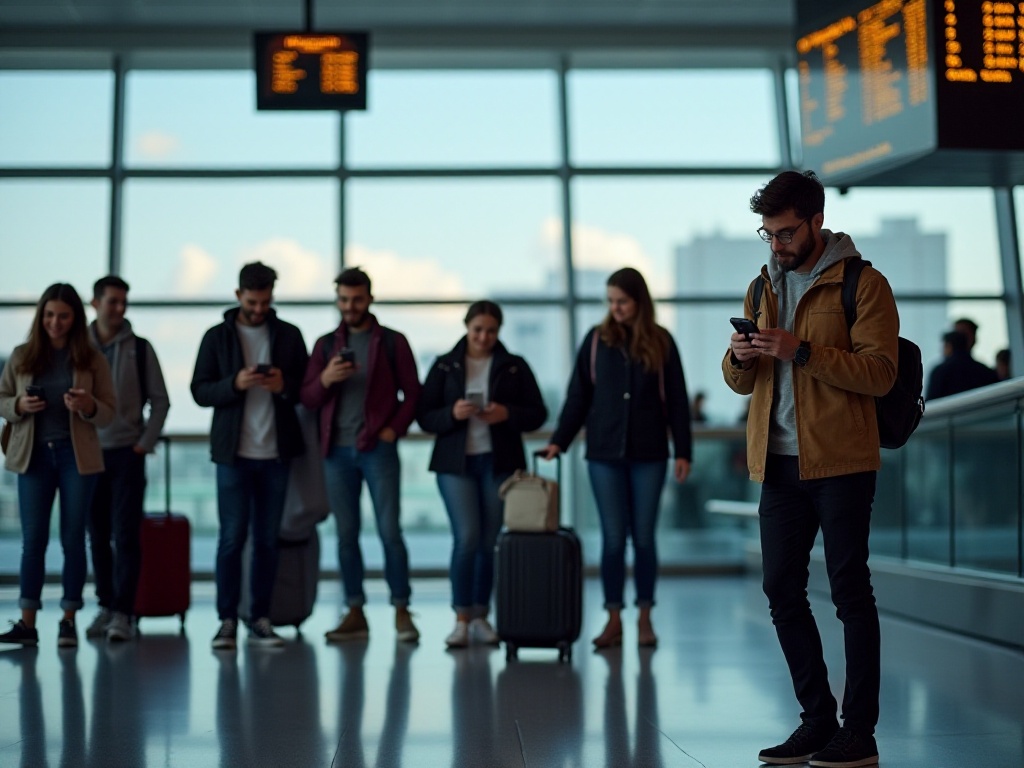Opening Thoughts
As a Travel blogger who's frequently on the road, I deeply understand the importance of appropriate digital tools for travel planning and experience. I remember my first solo trip to Europe when I almost missed my flight due to poor planning, spending excessive time looking for my gate at the airport. I was wandering around Charles de Gaulle Airport like a headless chicken, staring at the numerous signs on the ceiling but unable to find my gate. Finally, a kind airport staff member saw my anxiety and personally led me to the correct location. Since then, I've made a firm commitment to take travel planning seriously.
After years of exploration, I've finally found a set of digital tools that works for me. Now before each trip, I make thorough preparations and have all potentially needed tools ready. This not only makes travel more relaxing and enjoyable but also helps avoid many unnecessary troubles. Today I'll share my personal experience and recommendations, hoping to help fellow travel enthusiasts.
Trip Manager
Honestly, before discovering these digital tools, my travel plans were a complete mess. Flight bookings were buried deep in emails, hotel reservations were written on sticky notes, and attraction guides were saved in phone memos. It was time-consuming to check itineraries as I had to search through everything. Once in Thailand, I almost missed a schedule change notification sent a day ahead because I didn't check my email in time, which nearly affected my entire travel plan.
Everything became organized only after I discovered the amazing TripIt. Its most impressive feature is its ability to automatically compile a complete itinerary from your forwarded flight, hotel, and activity confirmation emails. This feature is perfect for frequent travelers like me.
Last month when I went to Japan, I had over a dozen confirmation emails for flights, hotels, and various activities. If I had organized them the old way, it would have taken half a day and I might still have missed important information. But with TripIt, it only took five minutes to organize everything clearly. What impressed me most was that it not only organizes all information neatly but also automatically alerts me about flight delays, gate changes, and other important updates.
For instance, when I was transferring from Tokyo to Osaka, my gate was changed due to a last-minute adjustment, and TripIt immediately notified me. Without this alert, I might have kept waiting at the original gate. It also automatically reminds me when to leave for the airport, considering travel time and security check time - such thoughtful features really provide peace of mind.
Speaking of another great travel planning assistant, Google Travel is worth mentioning. Its strength lies in integrating massive data from search engines to provide users with the most comprehensive travel suggestions. For example, when planning a trip to Kyoto, it not only helps find the cheapest flights and hotels but also recommends attractions and food based on my search history.
I remember when I was using Google Travel to plan my Kyoto trip, it reminded me that my planned week coincided with the Gion Festival. This information was crucial as the Gion Festival is one of Kyoto's most important traditional festivals, requiring advance booking for accommodation and event tickets. Without this reminder, I might have missed this rare cultural experience opportunity.
Besides these basic features, Google Travel also recommends some lesser-known but characteristic places. For instance, it recommended a century-old traditional Japanese confectionery shop in Kyoto, which wasn't in the main tourist area but offered truly unforgettable traditional sweets. Such personalized recommendations based on big data really make travel unique.

Packing Luggage
When it comes to the most headache-inducing part of travel preparation, it has to be packing luggage. I believe many people have experienced this: hurriedly packing before departure, always feeling like you're going to forget something important. Sometimes the worry leads to overpacking, resulting in a stuffed suitcase with half the items never being used.
I used to turn my house upside down every time I packed, afraid of forgetting something important. Often, I would lie in bed after packing and suddenly remember I hadn't packed my toothbrush, forcing me to get up and find it. Once on a trip to Northern Europe, I forgot to bring a power adapter and had to buy one locally, wasting both money and time.
Then I discovered the PackPoint app, which became my packing assistant. The app's brilliance lies in its ability to customize packing lists based on your specific itinerary. You just input your destination, travel dates, and planned activities, and it automatically generates a detailed packing list based on local weather and your schedule.
For example, if you're going to the beach, it reminds you to bring sunscreen, swimwear, and beach towels. If it detects that your destination might have rain in the coming days, it thoughtfully reminds you to bring an umbrella or raincoat. If you're planning to attend business meetings, it reminds you to pack formal wear and dress shoes. This way of creating lists based on actual needs really makes packing more efficient and targeted.
I remember once when I had to attend a week-long business conference and planned some local sightseeing afterward. Such itineraries combining formal and casual activities usually make packing particularly challenging. But with PackPoint's help, I quickly planned what clothes to bring: several sets each of formal wear, casual wear, and sportswear, along with necessary accessories and shoes. The final packing list ensured completeness without including unnecessary items.
Besides basic clothing items, PackPoint also provides special reminders based on your specific needs. For example, if you select "photography" as an activity, it reminds you to bring camera, chargers, memory cards, and other photography equipment. If you select "fitness," it reminds you to bring workout clothes, sports shoes, and gym towels. These detailed reminders are really thoughtful and help avoid many awkward situations.

On the Road
Finding your way in an unfamiliar city is probably a challenge every traveler faces. Especially in countries where you don't speak the language, it can be difficult even with navigation software. I often encounter situations where the navigation says the destination is nearby, but I just can't find the correct entrance. Or when trying to get from point A to point B, I'm unsure which transportation method is most suitable.
Rome2Rio is one of my most frequently used route planning tools. Its main feature is helping you find all possible transportation methods between two locations. Whether it's by plane, train, bus, taxi, or walking, it provides detailed options for you to choose from. Each option is marked with estimated time and approximate cost, allowing you to make the best choice based on your situation.
I really experienced this tool's power while traveling in Italy. From Rome to Florence, Rome2Rio listed several transportation options: a direct high-speed train taking only 1.5 hours; a long-distance bus taking over 3 hours but cheaper; or joining a day tour that includes stops at Tuscan towns along the way.
Rome2Rio clearly lists the advantages of different transportation methods. While the high-speed train is more expensive, it's the fastest and conveniently travels from city center to city center. The bus takes longer but is cheaper, and night buses can save a night's accommodation. Tour groups are the most expensive but include guide services and intermediate sight-seeing, suitable for those wanting a deeper travel experience.
Besides transportation options, Rome2Rio also provides practical tips. For example, it tells you how many exits a train station has and which exit is closest to your destination; or warns you that certain bus routes might be crowded during specific times, suggesting off-peak travel. These detailed pieces of information, though seemingly minor, can really make travel smoother.
While using Rome2Rio, I found it not only helps plan main transportation routes but also solves unexpected situations. Once in Venice, when my planned water bus was suspended for maintenance, Rome2Rio immediately recommended several alternatives, including walking routes and other public transportation options. This kind of flexibility really provides peace of mind.
Moreover, Rome2Rio's database is regularly updated with the latest transportation information from around the world. It covers not only major transportation hubs but also relatively remote locations. This is especially helpful for travelers who like to explore off-the-beaten-path destinations. For example, last year while traveling in Croatia, it helped me find ferry information from Split to Hvar Island.
Besides basic route planning, Rome2Rio also considers special circumstances. For international itineraries, it reminds you about visa requirements and transit times. For routes crossing multiple time zones, it automatically calculates time differences to avoid confusion. This thorough service really makes international travel easier.
In practical use, I found Rome2Rio's interface design very user-friendly. You can save interesting routes anytime for later review and comparison. It also supports offline downloads, allowing you to check basic route information without internet connection. This feature is particularly useful for travelers who often visit places with poor signal coverage.
Overall, Rome2Rio is like a personal transportation consultant, providing professional advice wherever you want to go. It not only saves time in route planning but also helps discover transportation options you might have overlooked. With this tool's help, even first-time visitors to unfamiliar places can plan routes as easily as locals.
Over the years, through continuously trying and using various digital tools, my travel experience has indeed improved significantly. From initially being overwhelmed to now handling everything smoothly, these tools deserve much credit. They not only make travel easier but also help us discover more interesting places and experiences. Of course, tools are just tools - what's most important is maintaining enthusiasm for travel and an exploratory mindset. I hope my shared experiences can help everyone, and wish everyone enjoyable and relaxing travels.


